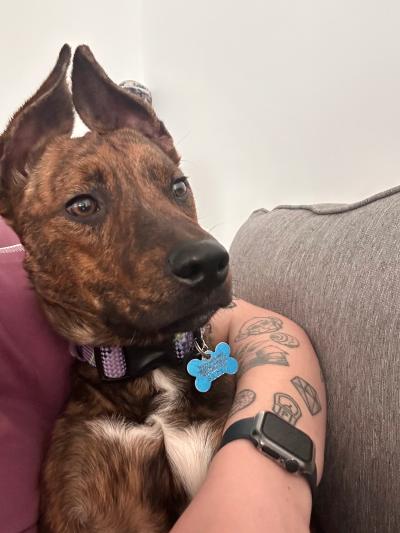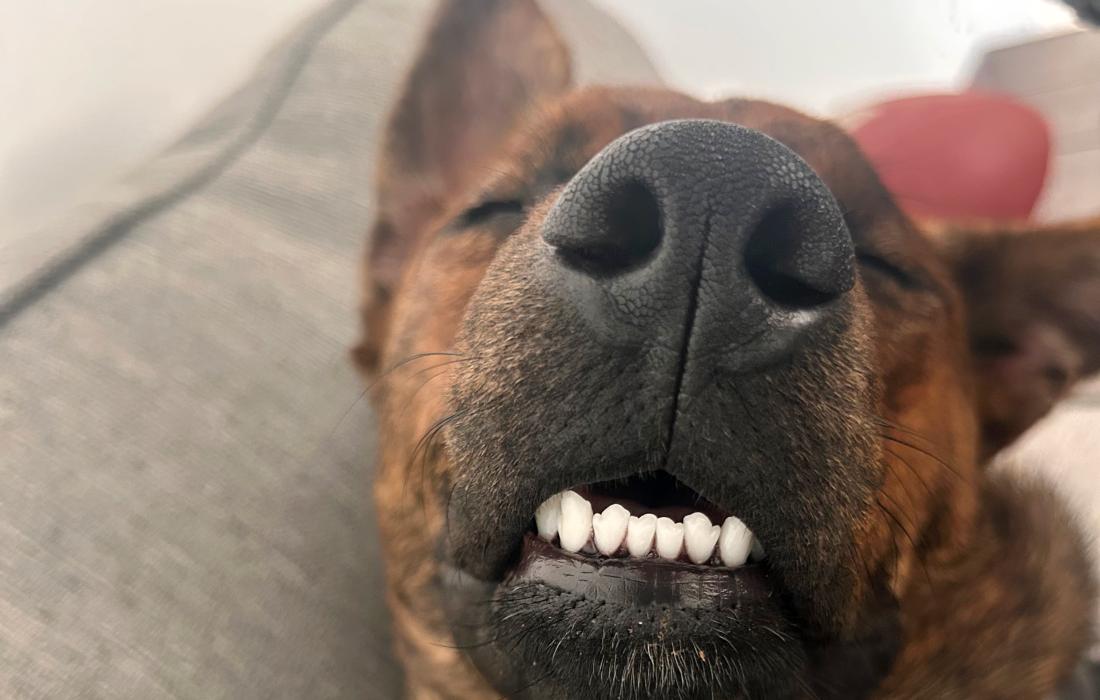Faces of No-Kill: Support for a special pup

Most puppies grow into their ears. Lexi wears hers like a crown — big, bold, and always a little bit ahead of the rest of her. It’s only fitting for a pup whose spirit is just as outsized and unforgettable.
Lexi arrived at Best Friends Animal Sanctuary from a nearby shelter, all wiggles and smiles (and ears). At first, everything seemed fine, but then she suddenly began to throw up food. Her caregivers quickly got her to the Best Friends clinic, where veterinarians thoroughly checked her out and discovered that she has megaesophagus — a condition in which the muscles of the esophagus don’t work properly, making it hard for food and water to reach the stomach.
This story is a part of our Faces of No-Kill series, highlighting the journey of pets who lost their place to call home. These pets are thriving today thanks to animal shelters that said yes to lifesaving and found a way to save them. Best Friends’ goal is for every shelter and every community to reach no-kill in 2025, and this story shows why that’s so important.
Patience, love, and a special chair
“While it may sound serious, megaesophagus is manageable with the right care, and many dogs live full, happy lives,” explains Dr. Colleen Guilfoyle, Best Friends veterinarian.
The most important part of management is feeding in an upright position. Lexi eats all her meals in a special chair — known as a Bailey chair — that keeps her head level with her food bowl and allows gravity to help move the food into her stomach. After each meal, she stays upright for 15 to 20 minutes to help the food go down smoothly and stay there.
[Best gift ever for an orphaned kitten with megaesophagus]
“There is no surgical cure, but with a consistent feeding routine and close monitoring, dogs with this condition can do very well,” says Dr. Colleen. In Lexi’s case, she’ll likely continue using her chair — and her post-mealtime snuggles — for the long haul.
Fortunately, Lexi had all the support she needed to thrive from the very beginning, thanks to foster caregiver Tina Sylvester, who brought her home.
“Honestly, she was just easy,” Tina says. “She was so good with my other dogs, she respected my cats, she learned quickly — everything that everybody’s looking for in a dog.”
As a veterinary technician in Dogtown at the Sanctuary, Tina brought Lexi to work regularly so potential adopters could see her.

An unexpected connection
One weekend, Katherine Vega and BreAnna Mower came to Kanab, Utah, for a hiking getaway. They brought their dogs along and decided to swing by the Sanctuary. They were planning to see horses — but instead found themselves in Dogtown, standing in front of a pup with ears so big and expressive that they practically introduced themselves.
“I asked about Lexi, and when we found out she had megaesophagus, I thought, ‘You know who’d be good at this? Us,’” Katherine says. They were confident they could learn what Lexi needed and adjust their routine to care for her.
[Survivor puppy shows big love for life]
Still, there was one big unknown: how their dogs — especially Cooper, who typically takes time warming up to new dogs — would respond. Staff helped arrange a meet and greet to see how they’d feel about the young pup with the big ears.
“We were sure it wouldn’t work,” BreAnna says. “But he didn’t even react. He just ignored her completely. We couldn’t believe it.”

Queen of the pack
The rest, as they say, is history — or in Lexi’s case, a very full present. She now lives with her two dog brothers (playfully bossing them around like the queen she is), snuggles up in the car after hikes, and tackles play sessions with joyful energy. After every meal, she climbs out of her special chair and sits with Katherine and BreAnna for cuddle time (and to let her food settle) three times a day, without fail.
“She’s totally worth it,” Katherine says. “With the right research and support, it’s really just like having any other dog — just with a few extra steps. And seeing how happy she is? It’s everything.”
Her ears? Still big. Still bold. Still sitting atop her head like a crown — and still leading with love, just like her heart.

Let's make every shelter and every community no-kill in 2025
Our goal at Best Friends is to support all animal shelters in the U.S. in reaching no-kill in 2025. No-kill means saving every dog and cat in a shelter who can be saved, accounting for community safety and good quality of life for pets.
Shelter staff can’t do it alone. Saving animals in shelters is everyone’s responsibility, and it takes support and participation from the community. No-kill is possible when we work together thoughtfully, honestly, and collaboratively.






